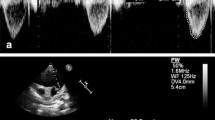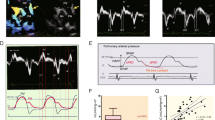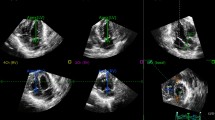Abstract
There is a paucity of data regarding the significance of left atrial (LA) volume and its changes throughout the cardiac cycle in pediatric patients with heart disease. The recently developed LA volume-tracking (LAVT) method can automatically construct the LA volume curve. The study group consisted of 48 pediatric patients with ventricular septal defect (n = 34) or patent ductus arteriosus (n = 14) and age-matched healthy controls. Maximum and minimum LA volumes (LAVmax and LAVmin, respectively) were measured. The total LA emptying volume (LAVtotal) was defined as LAVmax − LAVmin. Volume parameters were standardized by dividing by body surface area (BSA). The total LA emptying fraction (%LAVtotal) was defined as the ratio of LAVtotal to LAVmax. In the patient group, there was a positive correlation between the ratio of pulmonary to systemic blood flow (Qp/Qs) and LAVmax/BSA, LAVmin/BSA, and LAVtotal/BSA (r = 0.42, 0.44, and 0.34, respectively). LAVmin/BSA was positively correlated with the ratio of early mitral inflow velocity to early mitral annular diastolic tissue Doppler velocity (E/E′) (r = 0.32). The %LAVtotal had a negative correlation with left-ventricular (LV) end-diastolic pressure (r = −0.32). There were significant correlations between serum B-type natriuretic peptide level and LAVmax/BSA, LAVmin/BSA, and %LAVtotal (r = 0.38, 0.49, and −0.35, respectively). The LAVT method is useful in the evaluation of LV diastolic function in pediatric patients with chronic LV volume overload.

Similar content being viewed by others
References
Abhayaratna WP, Seward JB, Appleton CP, Douglas PS, Oh JK, Tajik AJ et al (2006) Left atrial size. J Am Coll Cardiol 47:2357–2363
Anwar AM, Soliman OII, Geleijnse ML, Nemes A, Vletter WB, ten Cate FJ (2008) Assessment of left atrial volume and function by real-time three-dimensional echocardiography. Int J Cardiol 123:155–161
Aurigemma GP, Gottdiener JS, Arnold AM, Chinali M, Hill JC, Kitzman D (2009) Left atrial volume and geometry in healthy aging: the cardiovascular health study. Circ Cardiovasc Imaging 2:282–289
Barclay JL, Kruszewski K, Croal BL, Cuthbertson BH, Oh JK, Hillis GS (2006) Relation of left atrial volume to B-type natriuretic peptide levels in patients with stable chronic heart failure. Am J Cardiol 98:98–101
Bursi F, Weston SA, Redfield MM, Jacobsen SJ, Pakhomov S, Nkomo VT et al (2006) Systolic and diastolic heart failure in the community. JAMA 296:2209–2216
Keller AM, Gopal AS, King DL (2000) Left and right atrial volume by freehand three-dimensional echocardiography: in vivo validation using magnetic resonance imaging. Eur J Echocardiogr 1:55–65
Koch A, Zink S, Singer H (2006) B-type natriuretic peptide in paediatric patients with congenital heart disease. Eur Heart J 26:861–866
Lang RM, Bierig M, Devereux RB, Flachskampf FA, Foster E, Pellikka PA et al (2006) Recommendations for chamber quantification. Eur J Echocardiogr 7:79–108
Lim TK, Ashrafian H, Dwivedi G, Collinson PO, Senior R (2006) Increased left atrial volume index is an independent predictor of raised serum natriuretic peptide in patients with suspected heart failure but normal left ventricular ejection fraction: Implication for diagnosis of diastolic heart failure. Eur J Heart Fail 8:38–45
Menon SC, Ackerman MJ, Cetta F, O’Leary PW, Eidem BW (2008) Significance of left atrial volume in patients <20 years of age with hypertrophic cardiomyopathy. Am J Cardiol 102:1390–1393
Murata M, Wanaka S, Tamura Y, Kondo M, Okayama K, Murata M et al (2008) A real-time three-dimensional echocardiographic quantitative analysis of left atrial function in left ventricular diastolic dysfunction. Am J Cardiol 102:1097–1102
Ogawa K, Hozumi T, Sugioka K, Iwata S, Otsuka R, Takagi Y et al (2009) Automated assessment of left atrial function from time-left atrial volume curves using a novel speckle tracking imaging method. J Am Soc Echocardiogr 22:63–69
Okamatsu K, Takeuchi M, Nakai H, Nishikage T, Salgo IS, Husson S et al (2009) Effects of aging on left atrial function assessed by two-dimensional speckle tracking echocardiography. J Am Soc Echocardiogr 22:70–75
Otani K, Takeuchi M, Kaku K, Haruki N, Yoshitani H, Tamura M et al (2010) Impact of diastolic dysfunction grade on left atrial mechanics assessed by two-dimensional speckle tracking echocardiography. J Am Soc Echocardiogr 23:961–967
Oyamada J, Toyono M, Shimada S, Aoki-Okazaki M, Tamura M, Takahashi T et al (2008) Noninvasive estimation of left ventricular end-diastolic pressure using tissue Doppler imaging combined with pulsed-wave Doppler echocardiography in patients with ventricular septal defects: a comparison with the plasma levels of the B-type natriuretic peptide. Echocardiography 25:270–277
Paul MA, Backer CL, Binns HJ, Mavroudis C, Webb CL, Yogev R et al (2009) B-type natriuretic peptide and heart failure in patients with ventricular septal defect: a pilot study. Pediatr Cardiol 30:1094–1097
Paulus WJ, Tschöpe C, Sanderson JE, Rusconi C, Flachskampf FA, Pacemakers FE et al (2007) How to diagnose diastolic heart failure: a consensus statement on the diagnosis of heart failure with normal left ventricular ejection fraction by the heart failure and echocardiography associations of the European society of cardiology. Euro Heart J 28:2539–2550
Redfield MM, Jacobsen SJ, Burnett JC, Mahoney DW, Bailey KR, Rodeheffer RJ (2003) Burden of systolic and diastolic ventricular dysfunction in the community. JAMA 289:194–202
Senzaki H, Kumakura R, Ishido H, Masutani S, Seki M, Yoshida S (2009) Left atrial systolic force in children: reference values for normal children and changes in cardiovascular disease with left ventricular volume overload or pressure overload. J Am Soc Echocardiogr 22:939–946
Ueda Y, Fukushige J, Ueda K (1996) Congestive heart failure during early infancy in patients with ventricular septal defect relative to early closure. Pediatr Cardiol 17:382–386
Author information
Authors and Affiliations
Corresponding author
Rights and permissions
About this article
Cite this article
Sakata, M., Hayabuchi, Y., Inoue, M. et al. Left Atrial Volume Change Throughout the Cardiac Cycle in Children With Congenital Heart Disease Associated With Increased Pulmonary Blood Flow: Evaluation Using a Novel Left Atrium-Tracking Method. Pediatr Cardiol 34, 105–111 (2013). https://doi.org/10.1007/s00246-012-0395-4
Received:
Accepted:
Published:
Issue Date:
DOI: https://doi.org/10.1007/s00246-012-0395-4




